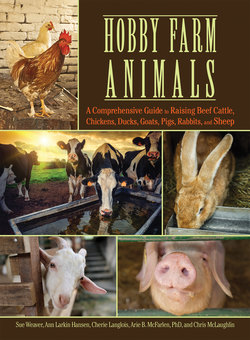Читать книгу Hobby Farm Animals - Chris McLaughlin - Страница 41
На сайте Литреса книга снята с продажи.
Chicken Classifications
ОглавлениеEarly on, the American Poultry Association (APA) devised a system for classifying chickens by breed, variety, class, and sometimes strain. A breed is a group of birds sharing common physical features such as shape, skin color, number of toes, feathered or nonfeathered shanks, and ancestry. A variety is a group within a breed that shares minor differences, such as color, comb type, the presence of a feather beard or muff, and so on. A class is a collection of breeds that originate from the same geographic region.
The APA currently recognizes twelve classes: American, Asiatic, English, Mediterranean, Continental, All Other Standard Breeds, Single Comb Clean Legged, Rose Comb Clean Legged, All Other Clean Legged, Feather Legged, Modern Game Bantam, and Game Bantam. A strain, when present, is a group within a variety that has been developed by a breeder or organization for a specific purpose, such as improved rapid weight gain and prolific egg production. Chickens may also be classified as light or heavy breeds or as layers, meat, dual-purpose, or ornamental fowl.
When the APA published its first Standard of Perfection in 1874, the following chickens were recognized: Barred Plymouth Rocks, light and dark Brahmas, all of the Cochins and Dorkings, a quartet of Single-Comb Leghorns (dark brown, light brown, white, and black), Spanish, Blue Andalusians, all of the Hamburgs, four varieties of Polish (white crested black, nonbearded golden, nonbearded silver, and nonbearded white), Mottled Houdans, Crevecoeurs, La Fleches, all of the modern games, Sultans, Frizzles, and Japanese Bantams. Today, close to 120 breeds and more than 350 combinations of breeds and varieties are described.
Bantams are one-fifth to one-quarter of the size of regular chickens. They come in sized-down versions of most large fowl breeds, although they aren’t scale miniatures: their heads, wings, tails, and feather sizes are disproportionally larger than those of their full-size brethren. A few Bantam breeds have no full-size counterparts. In addition to being cute, bantams can be shown, they make charming pets, and their eggs and bodies—small as they are—make mighty fine eating. The APA issues a standard for bantams, as does the American Bantam Association (these standards don’t always agree).
| A Matter of Breeding Some of today’s purebred fowl (chickens whose parents are of the same breed), such as the gamecock breeds, trace their roots to the distant mists of antiquity. Egypt’s elegant Fayoumi dates to before the birth of Christ. Stubby-legged, five-toed Dorkings came to Britain with the Romans. Squirrel-tailed Japanese Chabo Bantams, miniature chickens weighing between 1 and 3 pounds, emerged in the seventh century AD. Dutch Barnevelders were developed in the 1200s, about the time that Venetian merchant Marco Polo wrote of the “fur-covered hens” (Silkies) of Cathay. Another Dutch chicken, the deceptively named Hamburg, has existed since the late 1600s and is likely far older than that. The crested fancy fowl we call the Polish was developed even earlier, and France’s V-combed La Fleche dates to 1660 AD. Naked Necks, also called Turkens (possibly the weirdest-looking chicken of them all), originated in Transylvania before the 1700s. The first all-American fowl, the Dominique, is an early nineteenth-century New England utility fowl. |
